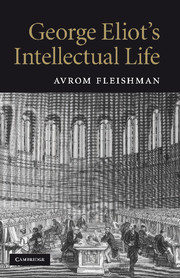Book contents
- Frontmatter
- Contents
- Acknowledgements
- Preface
- Introduction
- 1 The “Evangelical”: starting out in a Christian culture
- 2 The Apostate: moving beyond the Christian mythos
- 3 The Journalist: editing, reviewing, shaping a worldview
- 4 The Germanist: balancing the counterweight of German thinkers
- 5 The Novelist: mixing realism, naturalism and mythmaking
- 6 The Historian: tracking ideals – utopian and national – in Romola and The Spanish Gypsy
- 7 The “Radical”: taking an anti-political stance in Felix Holt
- 8 The Encyclopedist: transcending the past in Middlemarch
- 9 The Visionary: transmitting ideals in Daniel Deronda
- 10 The Intellectual: cultural critique in Impressions of Theophrastus Such
- Notes
- Works cited
- Name index
1 - The “Evangelical”: starting out in a Christian culture
Published online by Cambridge University Press: 05 April 2010
- Frontmatter
- Contents
- Acknowledgements
- Preface
- Introduction
- 1 The “Evangelical”: starting out in a Christian culture
- 2 The Apostate: moving beyond the Christian mythos
- 3 The Journalist: editing, reviewing, shaping a worldview
- 4 The Germanist: balancing the counterweight of German thinkers
- 5 The Novelist: mixing realism, naturalism and mythmaking
- 6 The Historian: tracking ideals – utopian and national – in Romola and The Spanish Gypsy
- 7 The “Radical”: taking an anti-political stance in Felix Holt
- 8 The Encyclopedist: transcending the past in Middlemarch
- 9 The Visionary: transmitting ideals in Daniel Deronda
- 10 The Intellectual: cultural critique in Impressions of Theophrastus Such
- Notes
- Works cited
- Name index
Summary
George Eliot was born Mary Anne Evans on November 22, 1819, and was baptised shortly afterward, thereby becoming a communicant in the Church of England, the Anglican Church. Its doctrines would dominate the first twenty-two years of her mental life, for more than a third of her life-span. It behooves any inquiry into her thought and art to consider the elements of her first culture, not only as a background to what came later but as a comprehensive worldview in their own right. Fortunately, there survives a bundle of letters to a former schoolmistress become friend, Maria Lewis, whom Gordon Haight believed to be the source of Eliot's early religiosity: “She also inculcated in the impressionable young girl a most painful form of Evangelical piety that frowned on every kind of worldly amusement” (Letters I, lxxii). There remains, in addition, a small number of letters to a former classmate and to her uncle and aunt, Methodist preachers both. It will be a first order of business to determine the tenets of Eliot's belief at this time (1836–41; aet. 16–22) and to compare them with the Evangelical principles of the period.
But first a note on terminology. Evangelicalism, the movement of a late eighteenth- and nineteenth-century Anglican Church party, is distinguished from the sectarian dissenting tendency known as evangelicalism – which included Eliot's aunt and uncle's Methodism – not only by remaining within the Church but by its doctrinal emphases and social activities.
- Type
- Chapter
- Information
- George Eliot's Intellectual Life , pp. 12 - 23Publisher: Cambridge University PressPrint publication year: 2010



